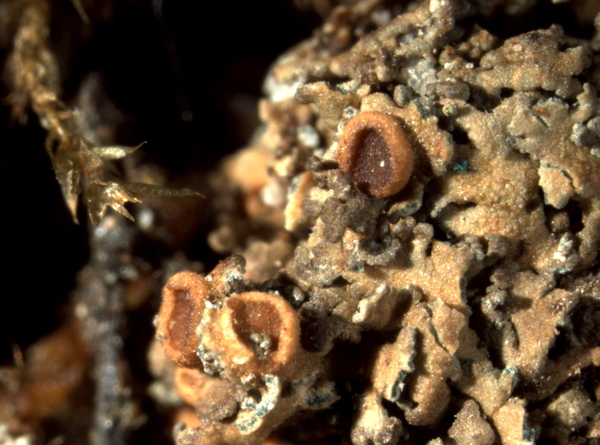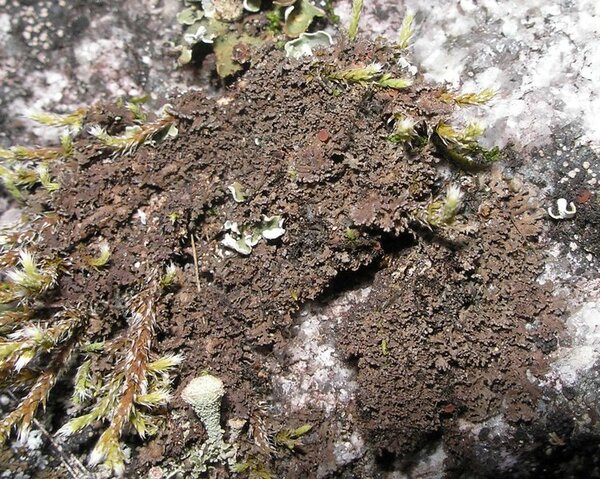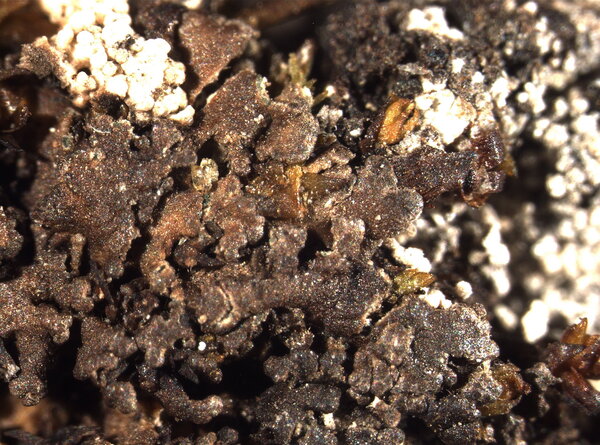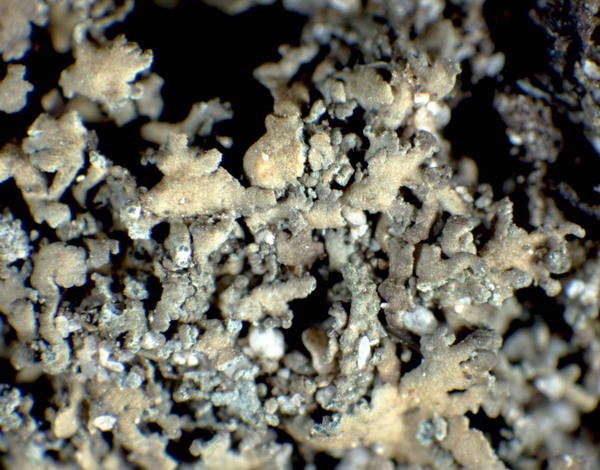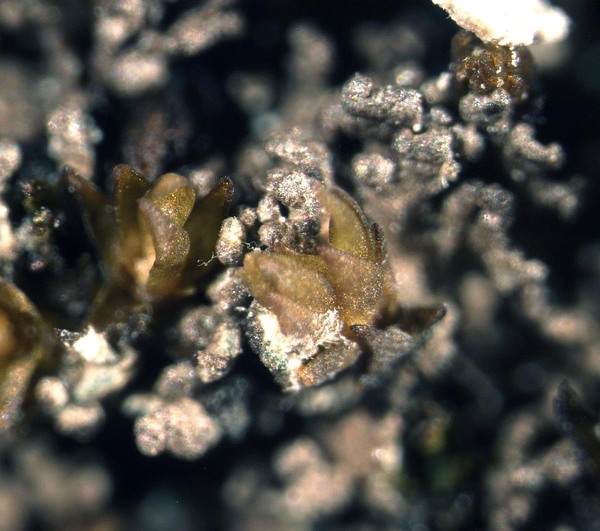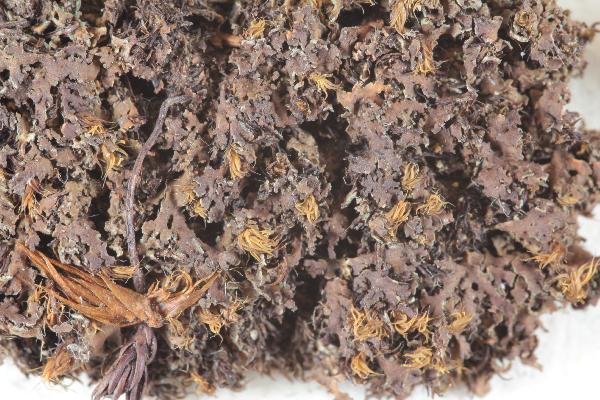Massalongia carnosa (Dicks.) Körb.
Syst. Lich. Germ.: 109, 1855. Basionym: Lichen carnosus Dicks. - Fasc. Pl. Crypt. Brit., 2: 21, 1790.
Synonyms: Biatora carnosa (Dicks.) Rabenh.; Lecanora muscorum Ach.; Pannaria muscorum (Ach.) Delise; Pannaria muscorum var. determinata Nyl.; Pannularia muscorum (Ach.) Stizenb.
Distribution: N - Frl, TAA (Nascimbene & al. 2021. 2022), Lomb, Piem (Isocrono & al. 2004), VA (Valcuvia 2000), Emil (Fariselli & al. 2020), Lig. C - Tosc (Nascimbene & al. 2021), Sar. S - Cal (Puntillo 1996).
Description: Thallus small-foliose to subsquamulose, heteromerous, 130-200 μm thick, red brown to blackish brown and often somehow glossy when dry, dark green to almost black when wet. Lobes crowded, initially rounded, then often elongate and c. twice as long as wide, flattened, 0.5-1.5(-2) mm wide, 0.5-3(-10) mm long, irregularly branched and overlapping, often forming 1-3 cm wide rosettes, the margins dissected by numerous, flattened, usually paler, isidia-like lobules or warts; lower surface whitish to pale brown, with sparse, pale brown rhizines. Upper cortex paraplectenchymatous, 25-30 μm thick; lower surface ecorticate, but with densely interwoven, longitudinally arranged hyphae. Apothecia rare, rounded, without a thalline margin, sessile to substipitate, up to 2 mm across, with a red-brown to flesh-coloured disc and a thin, paler brown, sometimes short-hairy proper margin. Proper exciple 100-150 μm wide, paraplectenchymatous, of isodiametrical cells; epithecium brownish, K-; hymenium colourless or brownish, (50-)70-90(-130) μm high, I+ deep blue; paraphyses coherent, simple, straight, 2-6 μm thick, the apical cells slightly swollen; hypothecium colourless, penetrated by photobiont cells. Asci 8-spored, cylindrical, fissitunicate, the thickened apex with a K/I+ blue ring, Fuscidea-type. Ascospores 1(-3)-septate, hyaline, fusiform to narrowly ellipsoid, (11-)15-25(-35) x 4.5-7(-8.5) μm, thin-walled, without epispore. Pycnidia rare, dark, the wall paler below, semi-immersed or projecting, to 0.6 mm in diam. Conidia bacilliform or slightly bifusiform, hyaline, 4-7(-9) x c. 1 μm. Photobiont cyanobacterial (Nostoc, the cells in short chains). Spot tests: K-, C-, KC-, P-, UV-. Chemistry: without lichen substances.Note: a circumpolar arctic-alpine to boreal-montane lichen found on bryophytes and soil rich in humus, on steeply inclined or rain-sheltered faces near the ground level, with optimum above or near treeline in areas with siliceous substrata; the species is certainly most frequent in the Alps, but it also occurs in the mountains of Calabria and Sardinia.
Growth form: Squamulose
Substrata: soil, terricolous mosses, and plant debris
Photobiont: cyanobacteria, filamentous (e.g. Nostoc, Scytonema)
Reproductive strategy: mainly sexual
Commonnes-rarity: (info)
Alpine belt: extremely rare
Subalpine belt: extremely rare
Oromediterranean belt: absent
Montane belt: extremely rare
Submediterranean belt: absent
Padanian area: absent
Humid submediterranean belt: absent
Humid mediterranean belt: absent
Dry mediterranean belt: absent
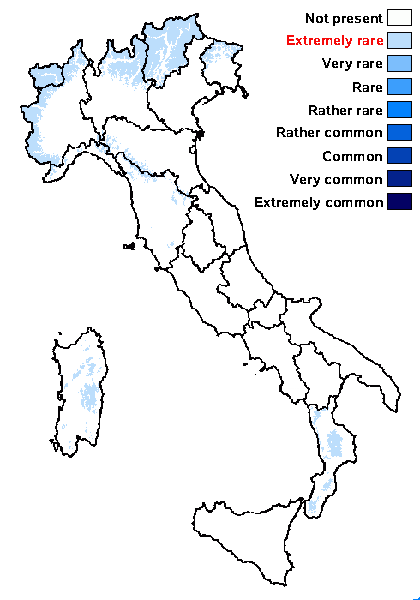
Predictive model
Herbarium samples
Growth form: Squamulose
Substrata: soil, terricolous mosses, and plant debris
Photobiont: cyanobacteria, filamentous (e.g. Nostoc, Scytonema)
Reproductive strategy: mainly sexual
Commonnes-rarity: (info)
Alpine belt: extremely rare
Subalpine belt: extremely rare
Oromediterranean belt: absent
Montane belt: extremely rare
Submediterranean belt: absent
Padanian area: absent
Humid submediterranean belt: absent
Humid mediterranean belt: absent
Dry mediterranean belt: absent

Predictive model
| Herbarium samples |
 INDEX FUNGORUM
INDEX FUNGORUM
 GBIF
GBIF
 DOLICHENS
DOLICHENS



